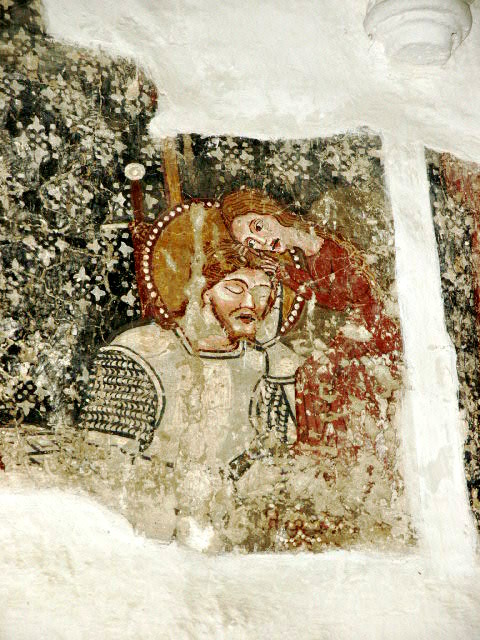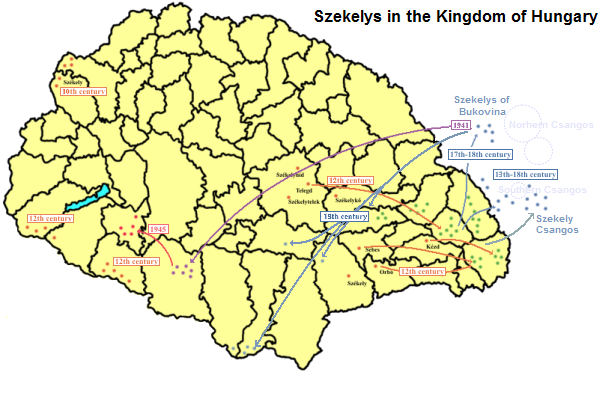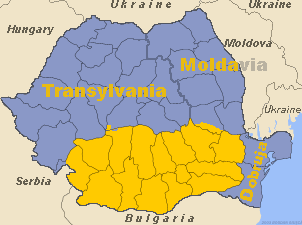|
Székelyudvarhely
Odorheiu Secuiesc (; , ; ) is the second largest municipiu, municipality in Harghita County, Transylvania, Romania. In its short form, it is also known as ''Odorhei'' in Romanian and ''Udvarhely'' in Hungarian. The Hungarian name of the town "Udvarhely" means "courtyard place". Demographics At the 2011 Romanian census, 2011 census, the city had a population of 34,257; among those for whom data were available, 95.8% were ethnic Hungarians in Romania, Hungarians, making it the urban settlement with the third-highest proportion of Hungarians in Romania. The city was also home to communities of ethnic Romanians (2.6%) and Romani people in Romania, Roma (1.5%). According to the 2021 Romanian census, 2021 census, Odorheiu Secuiesc had a population of 31,335; of those, 87.29% were Hungarians, 2.3% Romanians, and 1.58% Roma. As of 2011, half the population of the town professed Catholic Church, Roman Catholicism (50.05%), while the remaining half was primarily divided between Reformed ... [...More Info...] [...Related Items...] OR: [Wikipedia] [Google] [Baidu] |
Székely Land
The Székely Land or Szeklerland (, , Old Hungarian script, Székely runes: 𐲥𐳋𐳓𐳉𐳗𐳌𐳞𐳖𐳇; and sometimes ; ; ) is a historic and ethnographic area in present-day Romania, inhabited mainly by Székelys, a subgroup of Hungarians. Its cultural centre is the city of Târgu Mureș (Marosvásárhely), the largest settlement in the region. Székelys (or Szeklers) live in the valleys and hills of the Eastern Carpathian Mountains, corresponding mostly to the present-day Harghita County, Harghita, Covasna County, Covasna, and parts of Mureș County, Mureș counties in Romania. Originally, the name ''Székely Land'' denoted the territories of a number of History of the Székely people, autonomous Székely seats within Transylvania. The self-governing Székely seats had their own administrative system, and existed as legal entities from medieval times until the 1870s. The privileges of the Székely and Transylvanian Saxons, Saxon Seat (territorial-administrative uni ... [...More Info...] [...Related Items...] OR: [Wikipedia] [Google] [Baidu] |
Udvarhely County
Udvarhely () was an administrative county (Comitatus (Kingdom of Hungary), comitatus) of the Kingdom of Hungary. Its territory is now in central Romania (eastern Transylvania). The capital of the county was ''Székelyudvarhely'' (now Odorheiu Secuiesc). Geography Udvarhely county shared borders with the counties of Maros-Torda, Csík, Háromszék, Nagy-Küküllő, and Kis-Küküllő. The county lay in the Carpathian Mountains. Its area was 2,938 km2 around 1910. History Udvarhely county consisted of three former Seat (administrative division), seats of the Székelys: Udvarhelyszék, Bardóc and Keresztúr (the latter two as filial seats of the former). It was formed in 1876, when the administrative structure of Transylvania was changed. In 1920, by the Treaty of Trianon, the county became part of Romania until 1940 when, by the Second Vienna Award, much of its territory was reassigned to Hungary. After the end of World War II it became again part of Romania. Most of its te ... [...More Info...] [...Related Items...] OR: [Wikipedia] [Google] [Baidu] |
Treaty Of Trianon
The Treaty of Trianon (; ; ; ), often referred to in Hungary as the Peace Dictate of Trianon or Dictate of Trianon, was prepared at the Paris Peace Conference (1919–1920), Paris Peace Conference. It was signed on the one side by Hungary and, on the other, by the Allied and Associated Powers, in the Grand Trianon château in Versailles on 4 June 1920. It formally terminated the state of war issued from World War I between most of the Allies of World War I and the Kingdom of Hungary. The treaty is famous primarily due to the territorial changes imposed on Hungary and recognition of its new international borders after the First World War. As part of the Austria-Hungary, Austro-Hungarian Empire, Hungary had been involved in the First World War since August 1914. After its allies – Bulgaria and later Turkey – Armistice of Salonica, signed armistices with the Entente, the political elite in Budapest also opted to end the war. On 31 October 1918, Mihály Károlyi#Károlyi's ... [...More Info...] [...Related Items...] OR: [Wikipedia] [Google] [Baidu] |
Unitarian Church Of Transylvania
The Unitarian Church of Transylvania (; ), also known as the Hungarian Unitarian Church (; ), is a Nontrinitarian Christian denomination of the Unitarian tradition, based in the city of Cluj, Transylvania, Romania. Founded in 1568 in the Eastern Hungarian Kingdom by the Unitarian preacher and theologian Ferenc Dávid (c. 1520–1579), it is the oldest continuing Unitarian denomination in the world. It has a majority- Hungarian following, and is one of the 18 religious denominations given official recognition by the Government of Romania. The Transylvanian and Hungarian Unitarians represent the only branch of Unitarianism not to have adopted a congregationalist polity, and remains quasi- episcopal; the Irish Non-subscribing Presbyterian Church, a distinct body closely related to Unitarianism, has a presbyterian structure.Paul F. Bradshaw, ''The New SCM Dictionary of Liturgy and Worship'', SCM-Canterbury Press Ltd, London, 2002, p.460. The Unitarian Church of Transylvania is ... [...More Info...] [...Related Items...] OR: [Wikipedia] [Google] [Baidu] |
Hungarians In Romania
The Hungarian minority of Romania (, ; ) is the largest Minorities of Romania, ethnic minority in Romania. As per the 2021 Romanian census, 1,002,151 people (6% of respondents) declared themselves Hungarian, while 1,038,806 people (6.3% of respondents) stated that Hungarian language, Hungarian was their mother tongue. Most Hungarians, ethnic Hungarians of Romania live in areas that were parts of Hungary before the Treaty of Trianon of 1920. Encompassed in a region known as Transylvania, the most prominent of these areas is known generally as Székely Land (; ), where Hungarians comprise the majority of the population. Transylvania, in the larger sense, also includes the historic regions of Banat, Crișana and Maramureș. There are forty-one counties of Romania; Hungarians form a large majority of the population in the counties of Harghita County, Harghita (85.21%) and Covasna County, Covasna (73.74%), and a large percentage in Mureș County, Mureș (38.09%), Satu Mare Count ... [...More Info...] [...Related Items...] OR: [Wikipedia] [Google] [Baidu] |
Harghita County
Harghita County (, and , ) is a county () in the center of Romania, in eastern Transylvania, with the county seat at Miercurea Ciuc. Demographics 2002 census In 2002, Harghita County had a population of 326,222 and a population density of 52/km2. * Hungarians – 84.62% (or 276,038) * Romanians – 14.06% (or 45,870) * Romani – 1.18% (or 3,835) * Others – 0.14% 2011 census In 2011, it had a population of 302,432 and a population density of 46/km2. * Hungarians – 85.21% (or 257,707) * Romanians – 12.96% (or 39,196) * Romani * Others – 1.76% (or 5,326). 2021 census In 2021, it had a population of 291,950, and a population density of 43/km2. * Hungarians – 85.67% (or 232,157) * Romanians – 12.41% (or 33,634) * Romani - 1.82% (or 4,928) * Others – 0.1% (or 282). Harghita county has the highest percentage of Hungarians in Romania, just ahead of Covasna county. The Hungarians form the majority of the population in most of the county's municipal ... [...More Info...] [...Related Items...] OR: [Wikipedia] [Google] [Baidu] |
Wallachia
Wallachia or Walachia (; ; : , : ) is a historical and geographical region of modern-day Romania. It is situated north of the Lower Danube and south of the Southern Carpathians. Wallachia was traditionally divided into two sections, Muntenia (Greater Wallachia) and Oltenia (Lesser Wallachia). Dobruja could sometimes be considered a third section due to its proximity and brief rule over it. Wallachia as a whole is sometimes referred to as Muntenia through identification with the larger of the two traditional sections. Wallachia was founded as a principality in the early 14th century by Basarab I after a rebellion against Charles I of Hungary, although the first mention of the territory of Wallachia west of the river Olt dates to a charter given to the voivode Seneslau in 1246 by Béla IV of Hungary. In 1417, Wallachia was forced to accept the suzerainty of the Ottoman Empire; this lasted until the 19th century. In 1859, Wallachia united with Moldavia to form the Un ... [...More Info...] [...Related Items...] OR: [Wikipedia] [Google] [Baidu] |
Székelys
The Székelys (, Old Hungarian script, Székely runes: ), also referred to as Szeklers, are a Hungarians, Hungarian subgroup living mostly in the Székely Land in Romania. In addition to their native villages in Suceava County in Bukovina, a significant population descending from the Székelys of Bukovina currently lives in Tolna County, Tolna and Baranya County, Baranya counties in Hungary and certain districts of Vojvodina, Serbia. In the Middle Ages, the Székelys played a role in the defense of the Kingdom of Hungary#Middle Ages, Kingdom of Hungary against the Ottoman Empire, Ottomans in their posture as guards of the eastern border. With the Treaty of Trianon of 1920, Transylvania (including the Székely Land) became part of Romania, and the Székely population was a target of Romanianization efforts. In 1952, during the Socialist Republic of Romania, communist rule of Romania, the former counties with the highest concentration of Székely population – Mureș County#His ... [...More Info...] [...Related Items...] OR: [Wikipedia] [Google] [Baidu] |
John Sigismund Zápolya
John Sigismund Zápolya or Szapolyai (; 7 July 1540 – 14 March 1571) was King of Hungary as John II from 1540 to 1551 and from 1556 to 1570, and the first Prince of Transylvania, from 1570 to his death. He was the only son of John I, King of Hungary, and Isabella of Poland. JohnI ruled parts of the Kingdom of Hungary with the support of the Ottoman Sultan Suleiman; the remaining areas were ruled by Ferdinand I of Habsburg, who also ruled Austria and Bohemia. The two kings concluded a peace treaty in 1538 acknowledging Ferdinand's right to reunite Hungary after JohnI's death, though shortly after John Sigismund's birth, and on his deathbed, JohnI bequeathed his realm to his son. The late king's staunchest supporters elected the infant John Sigismund king, but he was not crowned with the Holy Crown of Hungary. Suleiman invaded Hungary under the pretext of protecting John Sigismund from Ferdinand. Buda, the capital of Hungary, fell to the Ottomans without opposition in 1541, ... [...More Info...] [...Related Items...] OR: [Wikipedia] [Google] [Baidu] |
Kingdom Of Hungary
The Kingdom of Hungary was a monarchy in Central Europe that existed for nearly a millennium, from 1000 to 1946 and was a key part of the Habsburg monarchy from 1526-1918. The Principality of Hungary emerged as a Christian kingdom upon the Coronation of the Hungarian monarch, coronation of the first king Stephen I of Hungary, Stephen I at Esztergom around the year 1000;Kristó Gyula – Barta János – Gergely Jenő: Magyarország története előidőktől 2000-ig (History of Hungary from the prehistory to 2000), Pannonica Kiadó, Budapest, 2002, , pp. 37, 113, 678 ("Magyarország a 12. század második felére jelentős európai tényezővé, középhatalommá vált."/"By the 12th century Hungary became an important European factor, became a middle power.", "A Nyugat részévé vált Magyarország.../Hungary became part of the West"), pp. 616–644 his family (the Árpád dynasty) led the monarchy for 300 years. By the 12th century, the kingdom became a European power. Du ... [...More Info...] [...Related Items...] OR: [Wikipedia] [Google] [Baidu] |
Michael The Brave
Michael the Brave ( or ; 1558 – 9 August 1601), born as Mihai Pătrașcu, was the Prince of Wallachia (as Michael II, 1593–1601), Prince of Moldavia (1600) and ''de facto'' ruler of Principality of Transylvania (1570–1711), Transylvania (1599–1600). He is considered one of Romania's greatest national heroes. Since the 19th century, Michael the Brave has been regarded by Romanian nationalism, Romanian nationalists as a symbol of Romanian unity, as his reign marked the first time in history all principalities inhabited by Romanians were under the same ruler. His rule over Wallachia began in the autumn of 1593. Two years later, Long Turkish War, war with the Ottoman Empire, Ottomans began, a conflict in which the Prince fought the Battle of Călugăreni, resulting in a victory against an army nearly three times the size of the army of Michael the Brave, considered one of the most important battles of his reign. Although the Wallachians emerged victorious from the battle, ... [...More Info...] [...Related Items...] OR: [Wikipedia] [Google] [Baidu] |
Habsburg Monarchy
The Habsburg monarchy, also known as Habsburg Empire, or Habsburg Realm (), was the collection of empires, kingdoms, duchies, counties and other polities (composite monarchy) that were ruled by the House of Habsburg. From the 18th century it is also referred to as the Austrian monarchy, the Austrian Empire () or the Danubian monarchy. The history of the Habsburg monarchy can be traced back to the election of Rudolf I of Germany, Rudolf I as King of the Romans, King of Germany in 1273 and his acquisition of the Duchy of Austria for the Habsburgs in 1282. In 1482, Maximilian I, Holy Roman Emperor, Maximilian I acquired the Habsburg Netherlands, Netherlands through marriage. Both realms passed to his grandson and successor, Charles V, Holy Roman Emperor, Charles V, who also inherited the Monarchy of Spain, Spanish throne and Spanish Empire, its colonial possessions, and thus came to rule the Habsburg empire at its greatest territorial extent. The abdication of Charles V in 1556 led ... [...More Info...] [...Related Items...] OR: [Wikipedia] [Google] [Baidu] |








